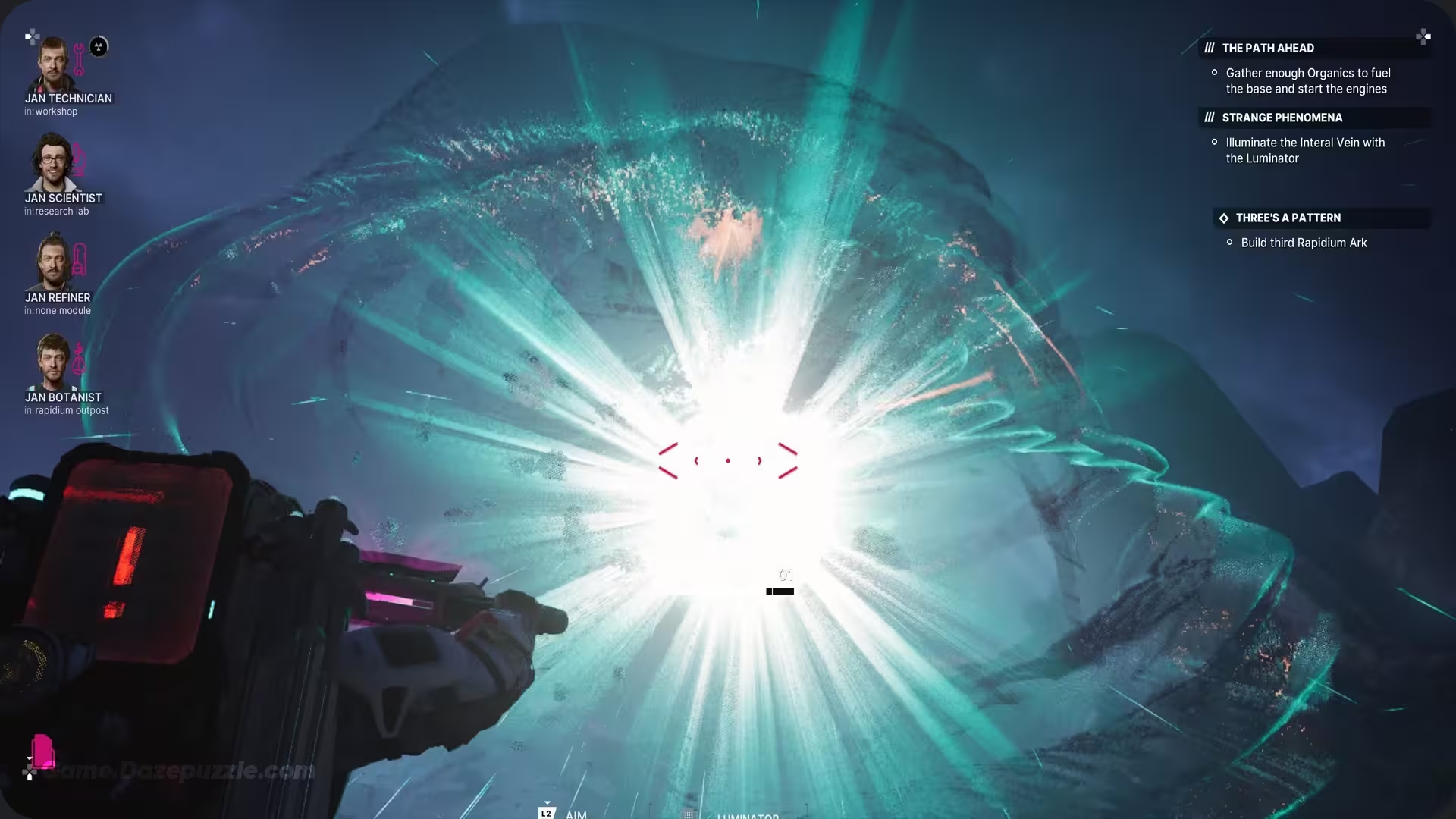The silence on this alien planet is a lie. You’re inside your mobile base, a lonely sanctuary against the crushing pressure of a world that wasn’t meant for you. The low hum of the life support is a constant companion, the rhythmic clanking of the fabricator a familiar tune. It’s almost peaceful. Then, it happens. A piercing alarm cuts through the quiet. Red lights flash across the metallic walls, bathing everything in a sense of urgent dread. On the main monitor, a single, terrifying word blinks in block letters: ANOMALY DETECTED.
This is the moment that The Alters, the highly anticipated sci-fi survival game from 11 bit studios, has been promising us. It’s not about fighting aliens with a pulse rifle. It’s about a battle against the unknown, a fight against chaos itself. As Jan Dolski, a simple worker stranded after a crash landing, your only hope for survival is to create alternate versions of yourself, the Alters. But as you build your strange, multiversal family, the planet pushes back.
The central question on every aspiring survivor’s mind is a simple but profound one: How do we fight back? More specifically, how to destroy anomalies?
If you’re looking for a simple “point and shoot” answer, you’ve come to the wrong place. The beauty and terror of what 11 bit studios is crafting seem to lie in a much more complex and rewarding system. Destroying anomalies won’t be about having the biggest gun; it’ll be about having the sharpest mind, the most specialized team, and the foresight to see the disaster coming before it even hits. Let’s power up the diagnostic tools and run a deep scan on everything we know.
What’s in out How to Destroy Anomalies in The Alters Guide?
What in the World Are Anomalies?
Before you can destroy something, you have to understand it. Based on the gameplay snippets, developer interviews, and environmental storytelling we’ve seen so far, anomalies aren’t a single, definable enemy. They appear to be a catch all term for any number of catastrophic events that threaten to rip your fragile existence apart. Forget a straightforward zombie horde; this is a far more insidious kind of enemy. We can likely categorize them into a few major types.
First, there are the Environmental Anomalies. Think of this as the planet actively trying to reject you. We’ve seen glimpses of strange, crystalline growths encroaching on the base, almost like a metallic cancer. We can speculate about other forms this might take: sudden radiation spikes that fry your electronics, corrosive fogs that eat away at the hull of your base, or seismic tremors that threaten to swallow your entire operation. These are physical, tangible threats that require an engineering or scientific solution. They are the problems you can see, but that doesn’t make them any less deadly.

Second, we have Systemic Anomalies. These are the internal disasters. Your base is a complex machine, a delicate web of power, life support, and resource processing. What happens when that web starts to break? A systemic anomaly could be a cascading power failure that plunges you into darkness and cold. It could be a critical malfunction in the oxygen recyclers, turning your safe haven into a ticking time bomb. Or perhaps it’s a software virus, a ghost in the machine, that turns your automated systems against you. These are the crises that test your technical prowess and your ability to triage under extreme pressure.
Finally, and perhaps most terrifyingly, there are the Psychological Anomalies. This is where The Alters truly shows its 11 bit studios DNA, echoing the human centric dread of Frostpunk and This War of Mine. Your crew isn’t a collection of nameless drones; they are all Jan Dolski, but from different life paths. They have hopes, fears, conflicting ideologies, and emotional baggage.
A psychological anomaly might not be a physical threat at all, but a crisis of morale. It could be a wave of debilitating despair that grinds productivity to a halt. It could be a violent schism between two Alters with opposing views, leading to sabotage and infighting. How do you “destroy” hopelessness? How do you “fix” a broken trust? This is where the game will move beyond simple survival and into the realm of profound human drama.
The Warning Signs: Reading the Planetary Tea Leaves
Anomalies don’t just happen. Like a storm gathering on the horizon, there will be signs. A core part of the gameplay loop will be learning to read these signs and recognizing the patterns of chaos. The true “meta” of The Alters won’t be about the perfect base layout, but about being a master diagnostician of impending doom.
So, what seeds of chaos should we be looking for? The primary trigger seems to be Jan’s state. The developers have spoken about the game being about the choices we make and the paths we don’t take. It stands to reason that Jan’s mental and physical health will be a central resource. Pushing him too hard, forcing him to work around the clock, and neglecting his well being could directly increase the probability of anomalies. A stressed out, exhausted Jan is more likely to make mistakes, which can lead to systemic failures. His psychological strain might even manifest directly into the world, blurring the line between his mind and reality in this strange quantum environment.

Resource mismanagement is another obvious culprit. Running low on power, water, or raw materials puts the entire operation on a knife’s edge. This is survival gaming 101. But in The Alters, the consequences are likely more complex. A power shortage doesn’t just mean the lights go out; it might disable the very monitoring systems that would warn you of an approaching environmental threat. A food shortage doesn’t just lower morale; it could spark a desperate conflict between your Alters, creating a psychological anomaly born from pure survival instinct.
But the most fascinating potential trigger is the very nature of your crew. The Alters you choose to create will define your capabilities, but they might also define your vulnerabilities. Creating a team composed entirely of hardened industrial workers might leave you brilliantly equipped to handle structural failures but completely unprepared for a complex scientific or psychological crisis. The specific combination of personalities and ideologies you bring together in your base could be the very thing that plants the seeds of a future disaster.
Your Multiversal Toolkit: Why The Alters Are Your Only Shot
This brings us to the heart of the matter: how to destroy these multifaceted threats. The answer is beautifully simple in concept and devilishly complex in execution: you don’t destroy the anomaly, your Alters do.
There will be no “Destroy Anomaly” button. Instead, victory will come from understanding the nature of the crisis and deploying the right Alter with the right skills and the right mindset to solve it. Your role as the player is that of a crisis manager, a psychologist, and a strategist, figuring out who is the best tool for a very specific, very dangerous job. Each Alter is a key, and your job is to find the right lock.
Let’s break down some speculative roles. The Technician Alter, the one who spent his life as a master engineer, is your go-to for systemic failures. When the power grid overloads, he’s the one who can navigate the complex circuitry to reroute power and prevent a total meltdown. He can fabricate custom parts, reinforce the base’s hull against environmental pressures, and keep the machinery of your survival humming.
The Scientist Alter, a Jan who pursued a life in academia, is your analyst and problem solver. When a strange crystalline growth appears, you don’t send a miner to hack at it. You send the scientist to take samples, analyze its composition, and identify a weakness. He’s the one who develops the chemical agent to dissolve it or the sonic frequency to shatter it. He fights with knowledge, turning the unknown into the known.

What about a Miner Alter? This hardened version of Jan, who spent his life in the depths of the earth, is your frontline explorer. He’s tough, resilient, and knows how to operate the heavy machinery needed to acquire rare resources from dangerous locations. When the Scientist figures out you need a specific, unstable isotope to power a device that can stop a radiation anomaly, the Miner is the one you send out into the storm to get it.
And then there’s the Psychologist or Diplomat Alter. This version of Jan may have no technical skills whatsoever. He can’t fix a generator or analyze a mineral. But when two of your key Alters are at each other’s throats, threatening to plunge the base into civil war, he is the most powerful weapon in your arsenal. He can mediate disputes, counsel the desperate, and restore the social cohesion required for everyone to function. He fights the anomalies that fester in the human heart.
The magic will come from combining these skills. Destroying a complex anomaly will almost certainly be a multi stage process that requires a symphony of different Alters working in concert.
If you want to Learn Everything about the Alters, Go and Read out The Alters Complete Walkthrough
A Theoretical Takedown: How to Destroy Anomalies
Let’s walk through a hypothetical scenario to see how this might play out.
The Crisis
The early warning system pings. A creeping, bioluminescent fog is rolling toward the base. Initial sensor readings are terrifying: it’s not just corrosive, it seems to be causing vivid hallucinations in anyone exposed to it. It’s an Environmental and Psychological anomaly rolled into one.
Step 1: Analysis (The Scientist’s Turn)
Your first move isn’t to build a wall. It’s to understand. You task your Scientist Alter to launch a sensor drone into the fog. He stays safely inside, poring over the data. He discovers the fog is a cloud of alien spores that attack both metal and the mammalian nervous system. But he also finds a weakness: the spores are rendered inert by intense, focused ultraviolet light.
Step 2: The Bottleneck (The Miner’s Challenge)
Great, you have a solution! But there’s a problem. Building a network of high intensity UV emitters around the base will require a massive amount of Quartz, more than you have in storage. The nearest significant deposit is in a treacherous, unstable canyon a few kilometers away. This is a job for your Miner Alter. You equip him with the best gear you have, and he heads out on a high stakes resource run while the fog gets closer and closer. The clock is ticking.

Step 3: Fabrication (The Technician’s Craft)
As the Miner risks his life, your Technician Alter gets to work. He’s in the workshop, using the Scientist’s schematics to build the emitter towers. This isn’t an instant process. He needs power, he needs fabrication time, and you need to manage his stress levels. If he panics, he could make a mistake, wasting precious time and resources.
Step 4: The Human Element (The Leader’s Role)
While all this is happening, panic is setting in. The proximity of the fog is starting to affect the crew’s morale. One of your other Alters is convinced this is the end and is advocating for abandoning the base, a suicidal move. Here, you deploy your Leader/Diplomat Alter. He sits down with the panicked Alter, talks him down, and reminds him of the plan. He restores order and focus, ensuring the team doesn’t collapse from within before the external threat even arrives.
Step 5: Execution
The Miner returns, just in the nick of time, with the Quartz. The Technician finishes the final emitter. You power them up. A perimeter of harsh, UV light encircles your base. The fog rolls in, hits the light, and the deadly spores instantly neutralize, becoming nothing more than harmless dust.

You didn’t just “destroy” the anomaly. You diagnosed it, engineered a solution, funded the operation, and managed the human cost. Every Alter was essential. That is the art of survival in The Alters.
The Best Offense is a Good Defense: Anomaly Prevention 101
The most skilled players won’t be the ones who are best at heroically cleaning up disasters; they’ll be the ones who prevent them from happening in the first place. A huge part of the long-term strategy will be proactive anomaly prevention.
This means thoughtful base management. Keeping your power grid stable, maintaining a healthy stockpile of essential resources, and regularly running system diagnostics can prevent most Systemic Anomalies. It means creating a base layout that is efficient and defensible.
More importantly, it means managing your people. This is the ultimate endgame. You’ll need to pay close attention to the needs and personalities of your Alters. Don’t put two ideologically opposed Jans in the same small living quarters. Make sure they have time for rest and recreation. Listen to their concerns. A happy, cohesive, and well rested crew is your number one shield against the chaos. By keeping the internal psychological state of your base healthy, you build a powerful resilience against the external threats of the planet.
The Alters is shaping up to be more than just another survival game. It’s a game about systems, both mechanical and human. The anomalies are not random events designed to annoy you; they are the consequences of your choices. They are the final exam for every decision you’ve made.
Destroying them won’t be a simple act of aggression. It will be an act of intelligence, of empathy, of teamwork, and of foresight. It requires you to be not just a worker, but a leader. You’ll need to understand that your greatest weapon isn’t a tool you can build, but the person you chose to be, and the people you choose to create. Now, what are your theories? How will you prepare to face the unknown?
Thanks for Keeping up with Game.Dazepuzzle.com






